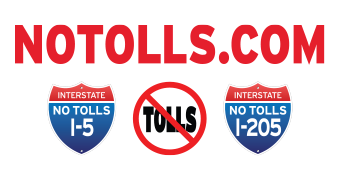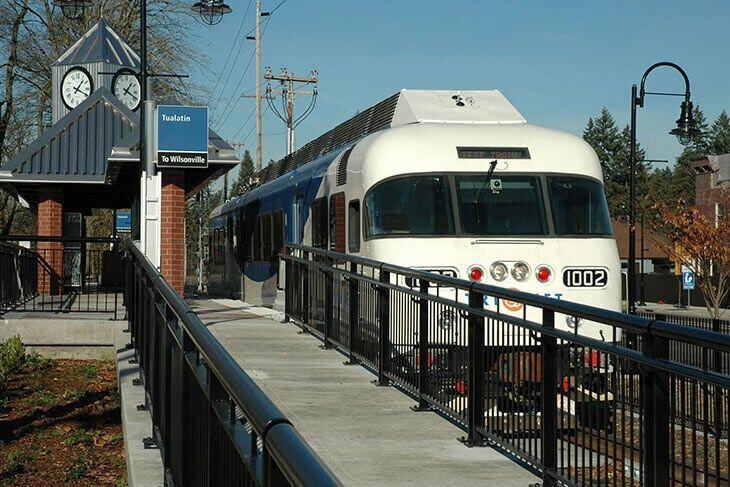Gorsek and McLain push for new tolls & expanded commuter rail in 2025 session
By Peter Wong
Lawmakers seek a study of little-used freight rail corridors in the Portland metro area — plus a new look at commuter rail between Wilsonville and Salem — as part of a planning effort for funding statewide transportation projects in 2025.
The next 160-day session that opens Jan. 13, not the current 35-day session that will close by March 10, is what the Legislature’s Joint Committee on Transportation is focused on. According to a tentative plan laid out by its Democratic co-leaders — Sen. Chris Gorsek of Gresham and Rep. Susan McLain of Forest Grove — the committee will seek public comment during at least 11 meetings around Oregon between March 17 in Portland and Aug. 15 in Washington County. (Locations and times have not been set.)
The process is similar to what lawmakers did in 2015 and 2016, following a failed attempt in 2015, and a multibillion-dollar plan passed in 2017.
Gorsek also said tolling is likely to be folded into the larger discussion on transportation legislation, which the committee hopes to complete by January 2025.
Though some Clackamas County residents vow to qualify a statewide initiative for the Nov. 5 general election — the measure would require voter approval for tolling — the Oregon Department of Transportation has a committee advising the agency on how tolling should be implemented on Interstate 205, which runs through Clackamas and east Multnomah counties. But action is not imminent, according to a report heard Jan. 24 by the Oregon Transportation Commission.
The Oregon and Washington commissions have approved an agreement that will lead to tolling on the proposed I-5 replacement bridge spanning the Columbia River between Portland and Vancouver, Washington. Two members from each state panel — Lee Beyer and Alicia Chapman will represent Oregon — will draft recommendations for the commissions to consider in the second half of 2025. The project itself awaits completion of a supplemental environmental impact statement, required for major federal actions, before construction can get underway in 2026.
Metro rail study
Gorsek said in an interview that the rail study would focus on mostly unused or underutilized corridors of the Portland and Western (P&W) Railroad, not tracks operated by BNSF or Union Pacific. If funded at $500,000, the study would be done by Metro, the regional planning agency.
“We’ve had discussions with P&W officials and they seemed interested in exploring the concept,” he said.
“When you look at all of the challenges with metropolitan freeways, we do not have other corridors. We do have rail corridors. They offer us a way to mitigate some of the congestion on the area freeways. This would supplement MAX,” he said, referring to the light-rail system operated by TriMet starting in 1986. “But it would be able to move people more quickly across the region.
“As we say we want to work on enhancing the system that we have — and we want to make sure that people have an alternative to paying tolls on the freeways — I think this is an attempt to open up what is an untapped corridor. We need the study to see what we could do, and then build on that.”
Many cities have mixed transit systems that rely on both light rail and commuter rail, the latter running on standard railroad tracks.
Gorsek said that pending legislation — Senate Bill 1572, sponsored by Sen. Aaron Woods, D-Wilsonville, which the committee planned to hear on Feb. 13 — would be folded into the larger effort.
TriMet, the regional transit agency, began its Westside Express Service (WES) between Wilsonville and Beaverton in 2009 after 10 years of planning and construction. The 14.7-mile line connects Wilsonville, Tualatin, Tigard and Beaverton and is one of the nation’s few suburb-to-suburb corridors. WES operates on Portland and Western lines only during morning and evening peak hours Monday through Friday.
Gorsek said that study would involve not only Wilsonville-Salem service on the P&W corridor — which ODOT has studied before — but also a loop back to Portland. Express bus service now links the Wilsonville WES station with Salem.
He said the studies have support from Senate President Rob Wagner, D-Lake Oswego, whose district contains parts of all three metro-area counties.
Valley rail service
Gorsek also said he expects the new transportation planning effort to look at what can be done to achieve higher rail speeds — but not necessarily high-speed rail, defined as 186 mph or greater — between Portland and Eugene. The Amtrak Cascades line, funded by Oregon and Washington, uses Union Pacific tracks in Oregon and BNSF tracks in Washington. ODOT has concluded that true high-speed rail in Oregon would require a separate corridor, possibly the P&W tracks.
The joint committee heard Jan. 12 from former U.S. Transportation Secretary Ray LaHood and former U.S. Rep. Peter DeFazio, the Oregon Democrat who led the House Transportation Committee from 2019 until he retired at the end of 2022. Both said that long-range planning for high-speed rail, which Washington state is pursuing, does not preclude higher speeds on existing tracks south of Portland.
“Many of us feel that the route from Portland to Eugene will be higher speed, not high speed,” Gorsek said.
“A lot of things could come together to make it a useful system. Obviously it would need to be upgraded. But it was good to hear from people in the know that bringing in that line would not impede higher speeds.”
Past efforts
The Oregon Legislature has approved three major transportation project and funding plans in the past two decades. The first one in 2003 focused $3 billion on repairs and replacement of bridges on key freight routes, many of which were being posted for weight limits. The second one in 2009 focused on highway and bridge projects.
The most recent one in 2017 was the first multimodal legislation. Although it offered $3.5 billion over a decade for highway safety and seismic improvements — about half for the state, half for cities and counties — the 2017 plan also instituted a statewide payroll tax for expansion of public transit at $100 million annually. The plan also funded two intermodal freight transfer stations — Nyssa is not complete; Millersburg is complete but not operational — and accommodations for electric vehicles and safe routes to school.
Under federal legislation that President Joe Biden signed in 2021, half of the $1.2 trillion went into renewal of federal spending authority on highways and bridges, but $550 billion went into an array of new transportation projects and programs. Oregon’s share for transportation projects was $1.2 billion, $400 million of which was considered flexible, and the rest earmarked in various categories.
The I-5 bridge replacement got a federal grant of $600 million, but officials in the two states are banking on an eventual total of $2.6 billion, plus $1 billion from each state. Tolls will account for the rest of the cost, which now is expected to exceed $5 billion. A new estimate is pending.


